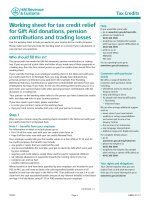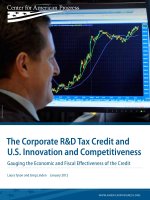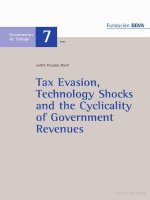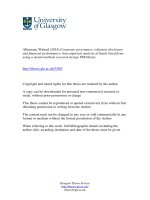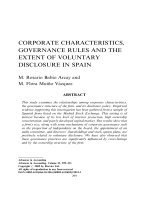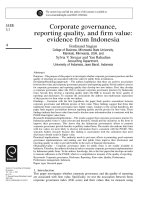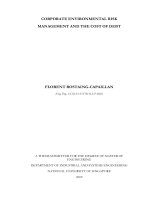Corporate income tax evasion and efficiency loss
Bạn đang xem bản rút gọn của tài liệu. Xem và tải ngay bản đầy đủ của tài liệu tại đây (218.22 KB, 46 trang )
CORPORATE INCOME TAX EVASION AND
EFFICIENCY LOSS
GU YAN YI
(B. ECON, PEKING UNIVERSITY)
A THESIS SUBMITTED
FOR THE DEGREE OF MASTER OF
SOCIAL SCIENCES
DEPARTMENT OF ECONOMICS
NATIONAL UNIVERSITY OF SINGAPORE
2009
i
ACKNOWLEDGEMENTS
On the completion of my thesis, I would like to express my deepest gratitude to all
those people whose kindness and advice have made this work possible.
I am greatly indebted to my supervisor Dr Younghwan In, for his effective advice,
illuminating instructions, valuable comments and constant encouragement.
I would like to express my heartfelt gratitude to the professors and teachers at the
Department of Economics, who have helped me a lot in the past two years.
Most of all, my thanks would go to my beloved family for their considerations and
confidence in me all through these years. I also owe my sincere gratitude to my
friends and my fellow classmates who gave me support during the difficult times.
ii
TABLE OF CONTENTS
TITLE PAGE .............................................................................................i
ACKNOWLEDGEMENTS .................................................................... ii
TABLE OF CONTENTS ........................................................................ iii
SUMMARY ..............................................................................................iv
1. Introduction ...........................................................................................1
2. Literature Review .................................................................................8
3. The model ............................................................................................13
3.1 Chen and Chu’s model ...............................................................13
3.2 Our concerns ...............................................................................16
3.3 Model 1 .........................................................................................19
3.3.1 No evasion case ...................................................................20
3.3.2 Evasion case ........................................................................24
3.4 Model 2 .........................................................................................29
3.4.1 To underreport ...................................................................30
3.4.2 To over-report .....................................................................31
4. Discussion of the Results ....................................................................36
5. Conclusion ...........................................................................................39
Bibliography ............................................................................................40
iii
SUMMARY
We set up a model to investigate corporate income tax evasion. The main difference
between individual tax evasion and corporate tax evasion is that the owners and the
managers of a corporation are usually separate from each other, thus they need to
cooperate when deciding to evade, which suggests that corporate tax evasion is a kind
of principal-agent problem. Managers need to be given enough incentive to evade
through a compensation package depending on the firm’s after-tax profit rather than
before-tax profit. We find that the optimal compensation scheme has to be altered
under evasion, which means an evading firm bears an extra cost of efficiency loss in
corporate governance in addition to the cost of being detected and penalized
compared to an individual, which we believe is an important factor in a firm’s
decision making process and for explaining the great difference in observed data.
iv
1. Introduction
There is a long history of taxation. Since there existed the concept of nation, there was
also the concept of taxation. Taxation is the important way a government earns
incomes. It seems that paying taxes is a citizen’s inherent obligation, while imposing
taxes is a government’s natural right. There is a long history of tax evasion as well.
Since there was taxation, there was tax evasion. Although some people voluntarily
pay their taxes no matter due to their strong sense of responsibility or the fear that not
paying is illegal, most people are not willing to pay out part of what they earn and
seeking the opportunity to shirk their tax liability, especially observing that some
people are not being punished for evading taxes. Therefore, governments can not
merely announce a tax system and expect to collect all the taxes they have planed to
raise. Tax authorities have to make effort to monitor and administer taxation, which is
not costless. Thus, it is beneficial to investigate the characteristics and determinants of
tax evasion, so that governments are able to improve their tax systems and enhance
the enforcement of taxation.
First of all, it is necessary to determine the extent of tax evasion; however, it is
difficult to measure because of its illegal nature. On one hand, no one will tell that her
actual income is larger than what she reports to be subject to taxation when filling a
questionnaire for research. On the other hand, the complexity of the law and the tax
system itself makes it ambiguous when determining whether an activity is illegal tax
evasion or legally permissible tax avoidance. The most credible source of information
about the extent of tax evasion comes from two programs conducted by the U.S.
1
Internal Revenue Service. The Taxpayer Compliance Measurement Program, done
from 1963 until 1988, was a program of intensive audits on a certain group of
taxpayers, combining with the information obtained from other studies about
particular sources of income, based on which, the IRS estimated the “tax gap”. Later,
the program stopped for complaints that such research was unfair; until recently, a
modified version, the National Research Program was implemented to analyze tax
returns from the 2001 tax year. After more than ten years, the IRS released their
estimates of tax underreporting gap for 2001.
In the IRS’s report, the aggregate tax underreporting gap was broken down into
individual income tax, employment tax, corporate income tax etc. Looking into the
data provided in Slemrod (2007), there are some interesting findings. Individual
income tax is further divided into underreported non-business income and
underreported business income. Non-business income is underreported by only 4
percent, while the underreporting rate of business income is much higher at 43 percent.
This is probably resulted from the fact that non-business income, such as wages and
salaries, or interest and dividends are reported by the employers or the firms who pay
them. There is less incentive for the reporters to hide the real information for those
who receive the money. However, the individual business income is under everyone’s
own control. Thus, the 43 percent basically reflects the extent of individual tax
evasion. This considerably higher rate is also associated with the high underreporting
rate of self-employment tax, which is estimated as 52 percent. For corporate income
tax, firms are classified into large ones and small ones based on their assets. Large
2
corporations underreport about 14 percent of their incomes, while the rate of small
corporations is slightly more than twice (29 percent); both are lower than that of
individual income tax.
Observing these data, we would like to raise several questions: why there is such
great difference in the underreporting rate among individual business income, small
corporations and large corporations? How tax evasion decisions are made and what is
the distinction between individual income tax and corporate income tax?
Intuitively, there are two possible explanations for the reality. One is that the
extent of penalty may be different between individuals and corporations; the other is
that the extent of auditing may also not be the same. The penalty varies from country
to country. In most countries, it is mainly in the form of a fine payment, but for severe
cases, the evaders may be given criminal conviction. For a company, normally it is the
legal person and the finance manager who take responsibility for the evasion. But
within a certain country, if it is stipulated that people involving in severe cases or
repeated cases should be put into jail, usually it applies to both individuals and
managements of a company. The other explanation is different auditing frequency. A
corporation’s profit exceeds a person’s income a lot, so a same or even a lower
underreporting rate of corporations perhaps means a much larger quantity which may
cause the tax authority to take more investigation, thus making the large corporations
harder to evade compared to individuals. Perceived this fact, some papers considered
the case under a varying auditing frequency which is related to the reported amount.
However in our work, we would like to show a third possible answer, thus we will
3
assume there is no distinction in these two factors. We assume a same punishment for
individual tax evasion and corporate tax evasion; besides we treat the possible legal
penalty and reputation loss as in the monetary term. We assume a detection
probability which is independent of the reported taxable income. In another word, an
identical tax system is supposed for these two kinds of tax evasion, but it will be
shown that corporations still exhibit lower underreporting tendency. We believe it
results from the organization form of modern corporations. Furthermore, it gives some
vague edification: unlike what we usually think, it seems that corporations do not
need monitoring as much as individuals do.
Beginning with the classic article of Allingham and Sandmo (1972), researches on
individual tax evasion developed a lot; however, although corporations play a central
role in the tax system, corporate tax evasion has not gain much attention. Most studies
on corporate tax evasion are not separate from those of individual ones in the
fundamental concept: there is just one individual who decides whether and how much
to evade. This is true for private business, where the owner runs the business herself,
including managing the tax reporting issues. However, it does not work in the exact
same way for public corporations. In public-held corporations, owners and managers
are usually apart from each other. Owners benefit from tax evasion by retaining a
higher after-tax profit, so that they have an incentive to evade tax as long as the
expected utility exceeds that of truthfully reporting. But a key point is that owners
generally do not report themselves, in stead, they have managers of the firm to make
these arrangements for them. Therefore, corporate tax evasion is not purely a problem
4
for one individual, but rather a more complicated issue which involves the interaction
between firm owners and their managers. Managers usually do not have the same
incentive as owners. Tax evasion will not benefit managers if managers are
compensated according to firm’s before-tax profitability. Furthermore, managers may
not be willing to participate in evasion since evasion is illegal, which might induce
penalty on them. Hence, if a firm determines to evade tax, it should firstly give
managers enough incentive to participate in this activity; in another word, firms
should compensate managers for bearing the risk of tax evasion. This suggests that
corporate tax evasion should be analyzed under a principal-agent framework, which
seeks to find ways to align managers’ incentives with firm owners’.
The first theoretical model of corporate tax evasion is proposed in Chen and Chu
(2005). They argued that the nature of illegality of evasion produces the
incompleteness of the compensation contract, which will distort the effort of the
manager and cause internal efficiency loss. We doubt that the contract designed in
Chen and Chu’s paper is not workable in reality, so in this paper, we make some twists
to their model. We will introduce their designation later, but in our model, we just use
a common simple contract, incorporating a “stock portion”, which tries to capture the
after-tax profitability so that the manager is rewarded not only for her effort in
managing the firm’s operations but also for the risk in participating in the evasion.
There is similar result as found in Chen and Chu: in the presence of tax evasion,
compensation contract must be changed from the second-best compensation scheme,
which will induce efficiency loss. The argument implies that firms have two sources
5
of costs when evading tax. One is the risk of being caught, which is also considered in
analyzing individual income tax evasion. The other one is the efficiency loss, which
we believe is the critical factor in corporate tax evasion. It can be used to explain what
is found from the empirical data. Because of one more consideration of tradeoffs,
firms exhibit a much lower underreporting rate compared to individuals. An
individual will evade taxes if the expected profit is higher from evasion than that from
honest reporting. A corporation will evade only when the expected profit is higher
enough to cover the internal efficiency loss.
We offer two models. The first one is a simple model where we assume the firm
owner can observe the true profit produced by the manager. The owner has two
choices, ordering the manager to truthfully report or allowing her to underreport. We
will show later that whenever the owner allows evasion, the manager will always
choose to evade. This assumption is made to eliminate the possibility for the manager
to overstate her performance. However, this kind of events does happen in the real
world. Owners usually do not know the sound status of their firms just like the tax
authority. They obtain the information by examining the financial statements prepared
by the managers, facing a problem that the managers might have the incentive to
over-report the profit so that they can earn a higher salary. Thus, in the second model,
we loosen the restriction: the owner cannot observe the true profit any more. She has
to design some certain compensation contracts to induce the manager to underreport,
truthfully report or over-report. We will show that this fact brings more efficiency loss
to the firm when tax evasion is a consideration.
6
The remainder of the thesis is organized as follows. In section 2 we provide a
literature review of tax evasion, focusing on corporate income tax evasion. In section
3 we set up the model. We will first discuss Chen and Chu’s model, and then explain
why we need to change the assumptions and what our model looks like. Section 4
presents the findings. Section 5 concludes.
7
2. Literature Review
The theoretical model of tax evasion was first provided by Allingham and Sandmo
(1972). In that paper, the authors analyzed how a risk-averse individual make decision
on whether and how much to evade taxes. Since underreporting will not necessarily
be detected, tax declaration decision is like gambling. Evasion may give the taxpayer
a higher pay-off, but it’s at the risk of being caught and penalized, thus being worse
off. Rational individual chooses how much to evade to maximize her expected utility.
The paper showed that optimal tax evasion level depends on the degree of risk
aversion, applied tax rate, penalty rate and the chance of getting caught.
This simple model has been extended in the following years in different
dimensions. One is to incorporate labor supply decision so that income is no longer
exogenously given, which brings interaction between labor supply decision and tax
evasion decision. Another aspect is to consider repeated games between taxpayers and
tax authorities, as people will update their knowledge and adjust their decisions with
previous experiences. Besides, there are researches on analyzing the situation that the
probability of audit is a function of reported income other than a constant rate. Some
other economists take into account the influence of people’s moral sense and the
fairness of the tax system. (Andreoni et al, 1998; Sandmo 2005)
While there are a number of papers addressing individual tax evasion following
Allingham and Sandmo, the study regarding corporate tax evasion is much less. Most
of the models assume that the owner of the firm makes decision on profit declaration.
8
Although the issue discussed is about business tax evasion, it is actually similar to that
of individuals. It is still a portfolio-selection problem, in which decision maker selects
the optimal level of the risky asset (evaded income which saves tax but induces
possible penalty). The main difference is that with the presence of tax evasion, the
choice of production might also be affected by tax rate, penalty size and auditing
frequency. Marrelli and Martina (1988) analyzed an oligopolistic market and showed
that optimal amount of tax evasion depends on the collusiveness as well as the relative
market shares. Virmani (1989) considered a more general case of a perfect
competitive market and concluded that tax evasion may lead to inefficient production
and thus imposing costs on the economy. A series of papers focused on the
relationship between these two decisions of a monopolist. Kreutzer and Lee (1986)
explored how profit tax can reduce monopoly distortion since successful tax evasion
will have an effect on the output level which maximizes the firm’s after-tax profit.
They showed that the overstatement of production costs induces the firms to increase
output. This opinion challenged the generally held point of view that profit tax is
neutral, i.e. it does not influence a monopolist’s profit maximizing level of output.
Wang and Conant (1988) derived a contrary result to them that the monopolist’s
optimal level of output is separate from the tax evasion decision, which reinforced the
conventional view. However, in Wang (1990), by endogenizing the probability of
detection and the penalty rate, it was concluded that the separability between the two
decisions no longer holds and the tax-evading monopolist may restrict output, even
worsening monopoly distortion. Further discussions can be found in Yaniv (1996),
9
Lee (1998), Panteghini (2000), Goerke and Runkel (2005).
However, the assumption that when choosing to underreport the profit, a firm acts
in the same way as an individual does is only reasonable with those small-sized and
privately-held firms. In large public companies, tax reporting decision, like most
producing or investment decisions, is usually made by CFO or the vice-president who
is in charge of tax affairs in stead of being directly determined by the owners. Because
of the separation between ownership and management, the problem of corporate tax
evasion is more complicated than individual ones. Slemrod (2004; 2005; 2007)
pointed out that corporate tax evasion should be analyzed under a principal-agent
framework – “to align the incentives of the decision makers and the shareholders, the
corporation should tie the agent’s compensation to observable outcomes that affect
after-tax corporate profitability” (2007).
There is paper investigating how manager’s own preference in evasion influence
her decision for the firm, e.g. in David Joulfaian (2000), but it is not the relationship
we are going to talk about. One of the earliest theoretical models to analyze the
problem in a principal-agent way was provided by Chen and Chu (2005), which is
also the fundamental model this paper relied on. The authors considered a game
between a risk-neutral principal (owner of the firm) and a risk-averse agent (manager).
They indicated that tax evasion is illegal and a contract based on illegal actions is not
enforceable. Manager bears the risk of being caught and punished, so the contract
should be able to compensate the manager not only her effort but also her risk in order
to induce her to participate in evasion, i.e. a higher wage when evasion is detected and
10
penalized. Besides, knowing that the contract will not be honored by the court if
evasion is detected, the risk needs to be compensated ex ante, which leads to the
incompleteness of the contract in the sense that the manager’s pay is not contingent on
whether evasion is detected or not. This failure in efficiently sharing the risk of
evasion by the owners and the manager creates distortion in the manager’s incentive
in exerting efforts. Their model implies that in addition to the tradeoff between
expected gain in evasion and the risk of getting caught, there is another tradeoff
between expected gain and efficiency loss for corporations. Therefore, even if the
expected gain from evasion less the expected penalty is positive, a firm will not
necessarily evade as efficiency loss might be extremely high. The authors also
discussed other potential reasons that can incur internal inefficiency when evasion
exists, e.g. agent’s extortion and repeated interaction.
Crocker and Slemrod (2005) examined this issue by considering a contractual
relationship between the shareholders of a firm and the CFO it hires. Under their
assumptions, the before-tax income of the firm is exogenously given (not depending
on the CFO’s effort). The CFO’s private information here is the extent of the legally
permissible tax reductions x, which the shareholders only have the idea of the
distribution density. Besides, the actual reduction in taxable income R is known to the
shareholders. Thus, there exists tax evasion of ( R − x ) which might be penalized upon
detecting. The main results found are: tax evasion will be reduced when penalties – no
matter levied on the firm or the CFO – increase; however, the penalty imposed on
CFO directly is more effective in reducing tax evasion, which provides guidance for
11
tax authorities in their enforcement policies.
In Desai et al (2003), the authors investigated the interaction between corporate
taxes and corporate governance using a different approach. They considered a game
involving tax authorities, inside shareholders who have the ability to divert corporate
value, and outside shareholders. Since attempting to avoid tax makes a firm’s
financial state opaque to outside investors, it becomes harder for outsiders to control
insiders. Thus, tax evasion will worsen the corporate governance. It is shown that
higher tax rate will worsen corporate governance as it increases the return of diverting
by insiders, thus providing more incentive for insiders to divert. On the contrary,
increase in tax enforcement helps to increase the difficulty of the insiders in diverting
corporate value into their own pockets, which favors the interest of outside
shareholders, and increases the market value of the firm, although the tax payment is
higher under this situation.
Later on, in Desai and Dharmapala (2006), the authors introduced the
principal-agent framework into the analysis. They argued that decisions about tax
evasion and rent diversion are interdependent on each other. Incentive compensation
aims to align the incentive of agents with the interests of the principals so that it
should induce the reduction in rent diversion and the increase in tax avoidance. Thus,
higher-powered incentive compensations should lead to more tax evasion. However,
the paper showed that the effect is ambiguous because of the interaction between the
two decisions.
12
3. The model
3.1 Chen and Chu’s model
Before introducing our model, we discuss Chen and Chu’s first. In their paper, a
standard principal-agent model where a risk-neutral principal hires a risk-averse agent
is presented. The manager exerts a certain level of effort e and then the firm will
realize a profit y with a density function of the realization of y, f ( y e ) ; it is assumed
that f ( y e ) first-order stochastically dominates f ( y e ' ) if e > e ' , which means more
efforts results in higher expected profit. The profit y is verifiable and observable to
both parties while effort level is the private information of the manager 1 . In the first
stage, the owner and the manager sign a contract of the compensation for the
manager, w ( y ) , which depends on the realized profit y. In the second stage, the
manager chooses an effort level to maximize her utility. The owner designs the
compensation contract in the first stage by solving the manager’s optimization
problem in the second stage, in order to maximize her after-tax profit. This is the
well-known method to give the manager enough incentive so as to work in the interest
of the owners.
However, if the owner intends to evade part of the firm’s true profit, the situation
becomes complicated. Given that tax evasion is illegal, the authors argued that the
previous contract will no longer be supported by the court and thus no longer
enforceable. Therefore, the manager has no incentive to evade tax since her
1
These are standard assumptions in principal-agent analysis developed by B. Holmsdrom (1979).
13
compensation will depend on the reported profit r rather than the true profit y. This is
because on one hand w (r ) is less than w ( y ) when evasion is profitable and successful,
while on the other hand if the owner refuses to pay according to y, the court won’t
enforce her to do that as officially the firm’s profit is r, so that rational owner will
always renege on the contract 2 . Knowing this, the manager will not be willing to help
the owner to underreport profit. Chen and Chu argued that the owner has to alter her
contract to induce the manager to do that. The new contract consists of two parts: a
wage contract w (r ) depending on the reported profit r and a so-called “service”
contract which is w ( y ) − w (r ) . In the first stage, the owner designs the contract and
the manager accepts it. In the second stage, the manager selects an effort level and a
certain profit y is realized. Observing this profit y, the owner chooses how much the
manager should report to the tax authority, r. This underreporting activity is seemed as
an extra “service” provided by the manager. Whenever she acts in this way, she will
get w ( y ) − w ( r ) in return. It was argued that this contract is enforceable because
officially reporting r means that the manager does provide the service and deserves
this payment, which will be supported by the court 3 . With this new contract, the
2
By “officially the firm’s profit is r” it means that since the company reports its profit to the tax authority as r, the
court will just take r as what the manager produces and according to which she can claim her compensation. The
true profit y is verifiable and observable to both the owners and the manager, but not to the public without any
investigation, otherwise the tax authority will always be able to obtain the real information and no evasion is
possible to exist. Furthermore, here it is assumed that only the tax authority will take investigation into whether the
profit is underreported, while the court’s work is just to enforce the contract. We will discuss this later.
3
Again, whether r is real profit or not is not the court’s concern. The problem for the court is to rule on how much
should be paid to the manager by the company according to their contract, taken r reported on the financial
statement published as true profit the manager produces. Therefore, under the former contract form, only w(r)
14
manager will be compensated w ( r ) + [ w ( y ) − w ( r )] = w ( y ) if she evades according to
the owner’s order, which is the same as being paid just w ( y ) if she dose not follow the
owner, but rather truthfully reporting the profit, so that the manager is indifferent
between evading and not evading, where as assumed she will opt to evade 4 . Since
actually the manager is paid according to the true profit y in this case, evasion
decision does not affect the optimal compensation contract and optimal effort level 5 .
Furthermore, there is potential penalty on the manager. Suppose that the manager
will be penalized by x ( y − r ) 6 if evasion is detected, so that paying w ( y ) is still not
enough for the manager to participate in evasion; she needs to be compensated more
for the risk. Again, this compensation should be made in the same way as the service
contract
does
for
the
same
reason.
Thus,
the
contract
becomes
{ w (r ) ; w ( y ) − w ( r ) + π ( y ) }, where π ( y ) is the risk premium. In order to induce the
manager to participate in evasion, this π ( y ) should satisfy that the manager will be
needed to be paid, while under the latter form, in addition to w(r), the “service payment” should also be paid.
4
Here the potential penalty to the manager is not considered. It will be explained in the next paragraph. This is for
the purpose of showing that even the manager is determined by law not liable for evasion, though it rarely happens,
the compensation contract has to be in a special form. The decision of evading in case of indifference is to ensure
the analysis to be meaningful. However, it sounds unreasonable. We suggest one possible explanation for why the
manager will choose to take the illegal activity: firstly, the compensation is the same, there is no loss for the
manager to perform illegally since it is assumed in this case that she can distinct herself from evasion; secondly, if
she does not obey the owners, she might lose her job in the future.
5
On one hand, the manager’s optimization problem is not changed. On the other hand, it is showed that the
optimal level of evasion is independent of the real profit, thus the difference of the owner’s problem between
evasion case and no evasion is just an additional constant term, which will not affect the solutions.
6
x is a function of (y-r), which means the penalty depends on the size of the evasion. We will explain the detailed
requirements x function should satisfy later in our model.
15
indifferent between receiving w ( y ) for sure, i.e. reporting truthfully, and evading with
the risk of being caught. Suppose that there exists a probability of p to be audited by
tax authority and once audited, evasion will be certainly detected, π ( y ) will be like
that to ensure the following equation hold:
pu [ w ( r ) + w( y ) − w( r ) + π ( y ) − x ( y − r )] + (1 − p )u[ w ( r ) + w( y ) − w( r ) + π ( y )] = u[ w( y )]
where u (⋅) is the agent’s utility function.
3.2 Our concerns
Nevertheless, we doubt whether the above-stated contract is workable in reality. A key
point for the contract to properly work is that the service contract will be supported by
the court, which guarantees the manager to be compensated no worse under evasion.
Chen and Chu ague that generally the court will only look into whether the manager
fulfills the requirements in the contract when being asked to enforce the service
contract, but will not check whether that r is true profit, so tax evasion will not be
uncovered because of this contract form. This argument promises the feasibility of the
contract proposed. However, we do believe that in the real world, the separation of
wage contract and service contract implies that there is manipulation in the profit
report, thus must lead the court to suspect and take investigation into the corporation.
With investigations, tax evasion will be found; because it is illegal, on one hand, the
legitimacy of the contract no longer exists, which means that the manager can no
longer expect to get the “service payment” through it, on the other hand, there is extra
penalty waiting for her, which tells that this kind of contract apparently cannot give
16
the manager enough protection that it intends to provide. Knowing all these, the
manager is better not to participate in the tax evasion. To solve the problem, we
abandon this kind of contract and make some more reasonable assumptions in our
models.
We consider a usual contract, which states that manager should be compensated
according to the reported profit r. r is verifiable and observable to both parties in both
models. But as explained before, when taking tax into consideration, the manager
needs to be compensated according to after-tax profit in order to induce evasion - this
can be realized through a fraction of “stocks”. Assume that after-tax profit is
completely reflected in the dividends paid and/or in the appreciation of the stock price.
In another word, by given the stock part, the manager possesses a proportion of
after-tax profit as a component of total compensation. Finally, the manager is
compensated a wage part and a stock part. There is some difference between the wage
here and that used in the standard principal-agent model, i.e. the wage is based on
how much profit reported instead of how much actually produced. Also, there is some
difference in the meaning of the stock part. We consider only one factor which
influences the value of the stocks, i.e. the after-tax profit, and we directly treat the
increase in the value of the stocks as the manager’s income. This is to let any potential
losses and risks related to tax evasion be compensated by the stocks given to the
manager. Moreover, let the manager to decide whether and how much to evade. There
is a trade off for the manager between receiving higher wages but lower gain in stocks
with reporting more and receiving fewer wages but more income from stocks with
17
evading more. A rational manager will choose to balance the tradeoff, and because the
choice is made by the manager herself, there is no conflict between the owner and the
manager. No matter whether to evade or not, how much to evade, it is an outcome
maximizing both the manager’s utility and the owner’s utility.
We are aiming to check how evasion decision brings efficiency loss, so we only
focus on the situations where the firm earns a positive profit, i.e. the firm should pay
some tax according to law. If the firm loses within a certain time horizon, no income
tax needs to be paid, thus no tax evasion decision. In another word, we suppose a
prerequisite that the true taxable income is greater than zero.
For simplicity, we assume linear contracts in both models. Manager will get a
salary linear in the reported profit and a proportion of stocks. In model 1, we assume
the principal can observe true before-tax profit, so that any over-report will be
prevented. In model 2, we loosen the assumptions: the owner does not observe the
exact true before-tax profit, providing the chance of over-report to the manager.
Because in model 1, over-report will not happen, to make the problem simple, we just
assume a fixed wage part plus stocks; while in model 2, a general wage function that
consists of a fixed part and a part increasing in the reported profit is considered. There
is a tradeoff for the manager: reporting higher profit means higher wage but lower
income as a shareholder; reporting lower profit means less wage but more earnings in
stocks. We discuss model 1 first.
18
3.3 Model 1
Suppose that before-tax profit the firm can generate depends on the manager’s effort.
Thus, higher effort means higher expected wage as well as more disutility caused by
working harder. Besides, the manager’s earnings are also affected by her tax reporting
strategy if the firm allows evasion because evasion may leave the firm with more
after-tax income, benefiting shareholders, including the manager.
The firm owner is assumed to be risk-neutral, while the manager exhibits constant
absolute risk-averse preferences. Let her utility be expressed by the following
exponential function:
u ( w, a ) = −e −η [ w−ψ ( a )]
where w is the total monetary compensation. η > 0 is the coefficient of absolute risk
aversion, and ψ (a) is a measure of the effort cost, a for effort level. Let the effort
1 2
cost function to be quadratic as ψ (a) = ca .
2
Suppose the owners and the manager sign a linear contract in the following form:
w = b + s (1 − t )( y − b)
where b is the fixed salary the manager will be paid and y is the realized before-tax
profit (revenue subtracting all the costs other than the manager’s salary). Thus,
( y − b) is subject to be taxed7 . s ∈ (0,1) is the proportion of stocks given to the
7
b should be small relative to y, however, it is a choice variable of the owners in the issue we are discussing,
which strictly speaking, affects the before-tax profit. We cannot treat it as the same as other costs, because all the
other costs, such as costs of raw materials, operation costs and other employees’ payroll etc, are determined by the
manager as a result of her effort in running the company, while b is out of the manager’s control. The ultimate
19
manager. t ∈ (0,1) is the applied tax rate.
Further assume that the before-tax profit is equal to manager’s effort level plus a
noise term:
y = a + ε , where ε ~ N (0,σ 2 ) 8 . But remember that our discussion is restricted
within the region of a positive profit.
3.3.1 No evasion case
The principal maximizes her utility by choosing the fixed salary b and the stock
proportion s. Meanwhile, through the compensation contract, she indirectly chooses
an optimal effort level. Thus, although effort is the manager’s decision, we include it
as one of the owners’ choice variables. The principal’s problem is as follows:
max E (1 − s )(1 − t )( y − b)
a ,b , s
subject to
E ( −e
1
−η [ b + s (1−t )( y −b ) − ca 2 ]
2
) ≥ u ( w)
(IR)
and
a ∈ arg max E (−e
1
−η [ b + s (1−t )( y −b ) − ca 2 ]
2
)
(IC)
a
where u (w) is the reservation utility level of the manager and w denotes the
before-tax profit actually is (y-b), where y is the result of manager’s behavior, while b is the result of owners’
behavior, which should be separated. The impact on before-tax profit produced by b cannot be included in y, thus b
should not be eliminated from the expression of taxable profit even though it is relatively small to y.
8
All the assumptions follow the model in Contract Theory, Chapter 4: Hidden action, moral Hazard. (Bolton,
Patrick and Dewatripont, Mathias, c2005).
20
minimum acceptable monetary equivalent of the manager’s compensation contract.
Given the contract, i.e. taking b and s as given, the manager tries to maximize her
expected utility.
E ( −e
1
−η [ b + s (1−t )( y −b ) − ca 2 ]
2
) = E ( −e
= ( −e
= ( −e
= ( −e
1
−η [ b + s (1−t )( a +ε −b ) − ca 2 ]
2
1
−η [ b + s (1−t )( a −b ) − ca 2 ]
2
1
−η [ b + s (1−t )( a −b ) − ca 2 ]
2
)
) E (e −ηs (1−t )ε )
η 2 s 2 (1−t ) 2 σ 2
)9
2
)(e
1
ηs 2 (1−t ) 2 σ 2
−η [ b + s (1−t )( a −b ) − ca 2 −
]
2
2
^
) = (−e −η w( a ) )
The maximization problem of the manager thus becomes to
1 2 ηs 2 (1 − t ) 2 σ 2
max w(a ) = b + s (1 − t )(a − b) − ca −
a
2
2
^
The first order condition is
s (1 − t ) − ca = 0 ⇒ a =
s(1 − t )
c
This is how much effort the manager will exert for any given incentive s.
9
See Contract Theory, Chapter 4: Hidden action, moral Hazard. (Bolton, Patrick and Dewatripont, Mathias,
2
c2005). When a random variable ε is normally distributed with zero mean and variance σ , we have
E (e γε ) = e γ
1
γε
E (e ) =
= eγ
since
σ2 /2
2
2πσ
1
σ2 /2
2
2πσ
1
2πσ
∫
for any γ
∫
+∞
−∞
∫
+∞
−∞
+∞
−∞
γε
−
−
e
−
e e
e
.
ε2
2σ 2
dε =
1
2πσ
∫
+∞
−∞
−
e
ε 2 − 2γσ 2ε
2σ 2
dε =
1
2πσ
∫
+∞
−∞
−
e
( ε −γσ 2 ) 2 −γ 2σ 4
2σ 2
dε
,
( ε −γσ 2 ) 2
2σ 2
dε = e γ
σ2 /2
2
( ε −γσ 2 ) 2
2σ 2
dε
is the area under a normal distribution with mean γσ 2 and variance σ 2 ,
which equals 1.
21
